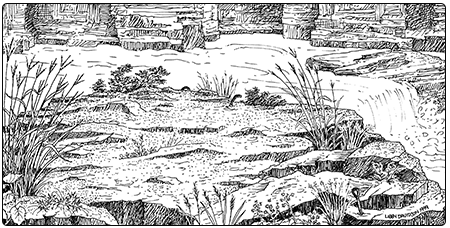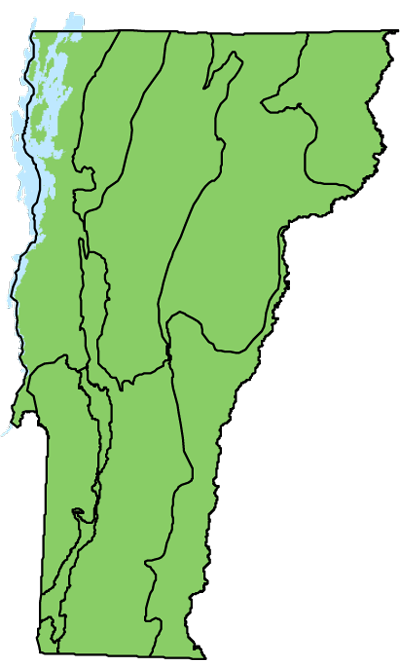Ecology and Physical Setting
Riverside Outcrops are places along rivers and streams where bedrock is exposed and treeless. They are most common where waters are swift, such as at narrows, gorges, rapids, and falls. The large rivers, like the Connecticut, Winooski, Lamoille, Missisquoi, and White, have the most extensive Riverside Outcrops. Smaller rivers and streams, with less extensive flooding and less ice to scour banks, tend to have smaller outcrops.
Like outcrops away from rivers, Riverside Outcrops are exposed to the heat of the sun and have minimal soil. They are distinct in that they are influenced by river processes. Where outcrops are within a few feet of river level, they are scoured regularly in the winter by ice as it expands and pushes up on the banks, and also in spring as the great floes move downstream on spring floods. The scouring kills most woody plants by damaging the growing tissue in their bark, or by simply shearing them off. Where outcrops are within the zone of flooding, high water deposits sediments in the rock crevices, creating miniature pockets of alluvial silt or silt loam, soil types that are more commonly found in floodplain forests. These loamy pockets of soil tend to be nutrient-enriched and hold moisture well, in contrast to the nutrient-poor soils that develop in place on some other kinds of rock outcrops. And where outcrops are near falls, they are bathed in mist, which provides needed moisture. Valley fog gives Riverside Outcrops added moisture, too, especially in late summer and fall.
Riverside Outcrops can be nearly level to gently sloping. With steeper slopes, less soil accumulates, and vegetation is more sparse. The steepest rock faces along rivers are better classified as cliffs. Some Riverside Outcrops are formed by erosion of bedrock over millennia—this process creates gorges, and in some gorges the exposed rock can be far above the present-day river.
Riverside Outcrops occur on many types of rock. Schists and phyllites line much of the Connecticut, schists and grey limestones are common on the White, and dolostone can be found on the lower Winooski. Granite is seen very locally, as on a short stretch of the West River in southern Vermont and in a few localities on the Moose River in northeastern Vermont. Variations in bedrock chemistry and structure are reflected in the vegetation.
Vegetation

rivershore communities.
Substrate is everything to plants. Just as cattails thrive in mucky soils, harebells are one of the few species that can survive the harsh conditions created by open bedrock. Many of the plants that grow on Riverside Outcrops are there as much because there is rock as because there is a river. In fact, many plants, like harebell, seem to be indifferent to the presence of water nearby. Downy goldenrod and spreading dogbane are as common away from rivers as they are near them. On the other hand, there are a few species that seem to do best where there is alluvial soil deposited by a river each year, filling the cracks in the rock with fine, fertile soil. Wild chives and shining ladies’ tresses are among these. Others, like cut-leaved anemone and many species of bryophytes, seem to thrive where there is a constant supply of mist from a waterfall.
The openness of the habitat, resembling as it does an open field or roadside, is also quite hospitable to a number of non-native species that are adapted to disturbed soils. Riverside Outcrops, therefore, have more than their share of species of Eurasian origin.
Wildlife Habitat
Riverside outcrops are promontories on the river shore from which birds and mammals can observe the adjacent river as they hunt for food. Belted kingfishers, green herons, great blue herons, and bald eagles all feed on fish and can be seen perched on outcrops, stalking prey on shorelines, or flying overhead. Mink may be seen stealthily hunting along the river edge. Otters may use Riverside Outcrops as “latrines”—prominent places where they defecate regularly to mark their territory. These latrines can be recognized by tufts of scraped and twisted vegetation, a distinct fishy smell, and fish bones and crayfish parts in the scat.
A more cryptic visitor to these outcrops is a ground-nesting macropis bee (Macropis nuda) that is unusual in that it forages on floral oils instead of nectar like most bees. This bee forages specifically on the oils produced by the plant genus Lysimachia. Fringed loosestrife, a member of this genus, is commonly found on Riverside Outcrops.
Related Communities
- Calcareous Riverside Seep may be found where bedrock is exposed, but it differs in having a more-or-less constant supply of seepage water, which creates wetland conditions and supports a rich flora.
- Rivershore Grasslands have dense vegetation and occur on gravel or cobble shores along the river margins.
Conservation Status and Management Considerations
Riverside Outcrops may be one of the most permanently altered community types in the Northeast. Because the largest and best examples tend to be found near falls and gorges on major rivers, a number of them have been blasted, riprapped, covered with concrete, or flooded by the building of dams for power generation. This alteration began in small ways in the late-18th century, with a small mill on every minor stream near a settlement. It escalated to major dam-building on the largest rivers with the industrialization of the 19th century. The 20th century saw the advent of numerous new power-generating dams, and the most recent blow to Vermont’s Riverside Outcrops came in the name of property protection, with flood control dams built from the 1930s to the 1950s to prevent a repeat of what happened in 1927. The White River is the only free-flowing, undammed, major river in the state.
Vermont has very few endemic species—species that are found only in this state and nowhere else in the world. One of these endemic species, Robbins’ milk-vetch, was found on an outcrop on the lower Winooski River. This plant is now extinct, probably due to a power generating facility that was built in the 19th century in the gorge where the plant grew. This is only one story of one plant; many large and diverse natural Riverside Outcrops were destroyed, and what was lost will never be known.
Today, the value of these communities is recognized by conservation organizations and local planners, and several examples are protected on private and public conservation lands.
Distribution/Abundance
Riverside Outcrops are found on rivers and streams throughout Vermont, though they are nowhere abundant or large. They are found on all the larger rivers, including the Connecticut, White, West, Black, Ottauquechee, Deerfield, Winooski, Lamoille, and Missisquoi. Communities with similar groups of species occur in all New England states, and in New York and adjacent Canada.
Characteristic Plants
Herbs and Woody Vines
Abundant Species
Harebell – Campanula rotundifolia
Balsam ragwort – Packera paupercula
Shining ladies’ tresses – Spiranthes lucida
Pointed-leaved tick-trefoil – Hylodesmum glutinosum
Poison ivy – Toxicodendron radicans
Canada anemone – Anemone canadensis
Fringed loosestrife – Lysimachia ciliata
Joe-pye weed – Eutrochium maculatum
Spreading dogbane – Apocynum androsaemifolium
Virgin’s bower – Clematis virginiana
Northern bugleweed – Lycopus uniflorus
Wild columbine – Aquilegia canadensis
Thimbleweed – Anemone virginiana
Occasional to Locally Abundant Species
Big bluestem – Andropogon gerardii
Downy goldenrod – Solidago puberula
Marsh bellflower – Campanula aparinoides
Tufted hairgrass – Deschampsia cespitosa
Non-native Plants
Canada bluegrass – Poa compressa
White sweet clover – Melilotus albus
Ox-eye daisy – Leucanthemum vulgare
Queen Anne’s lace – Daucus carota
Yarrow – Achillea millefolium
Common mullein – Verbascum thapsus
Cypress spurge – Euphorbia cyparissias
Non-native Invasive Plants
Black swallowwort – Cynanchum louiseae
Morrow’s honeysuckle – Lonicera morrowii
Rare and Uncommon Plants
Cut-leaved anemone – Anemone multifida
Smooth cliffbrake – Pellaea glabella
Hyssop-leaved fleabane – Erigeron hyssopifolius
Tradescant’s aster – Symphyotrichum tradescantii
Dwarf bilberry – Vaccinium caespitosum
Stout goldenrod – Solidago squarrosa
Jesup’s milk-vetch – Astragalus robbinsii var. jesupii
Wild chives – Allium schoenoprasum
Great St. Johnswort – Hypericum ascyron
Whorled milkwort – Polygala verticillata
Long-headed thimbleweed – Anemone cylindrica
Graham’s rockcress – Boechera grahamii
Redtop panic grass – Coleataenia rigidula
River-ledge goldenrod – Solidago racemosa
Purple false oat – Graphephorum melicoides
Mountain cranberry – Vaccinium vitis-idaea
Associated Animals
River otter – Lontra canadensis
Mink – Neovison vison
Belted kingfisher – Megaceryle alcyon
Green heron – Butorides virescens
Great blue heron – Ardea herodias
Bald eagle – Haliaeetus leucocephalus
Spotted sandpiper – Actitis macularius
Macropis bee – Macropis nuda
Places to Visit
Quechee Gorge, Hartland, Quechee State Park, Vermont Department of Forests, Parks, and Recreation
White River Wildlife Management Area, Sharon, Vermont Fish and Wildlife Department
